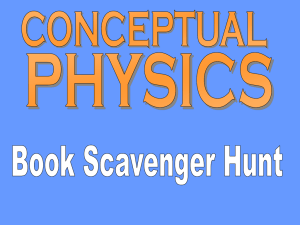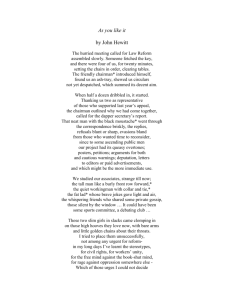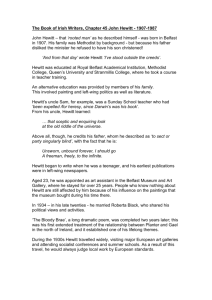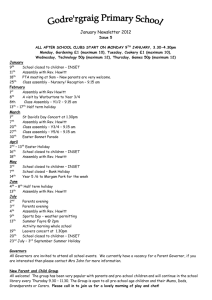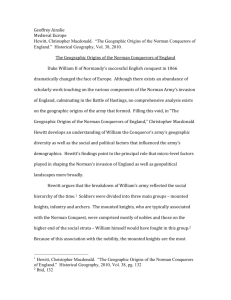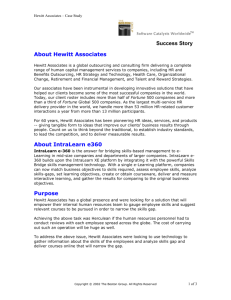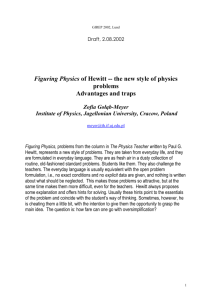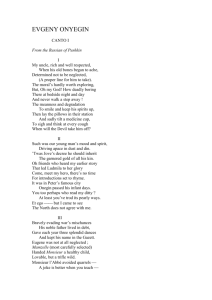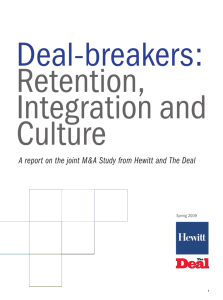Honors Physics Syllabus - Mater Academy Lakes High School
advertisement
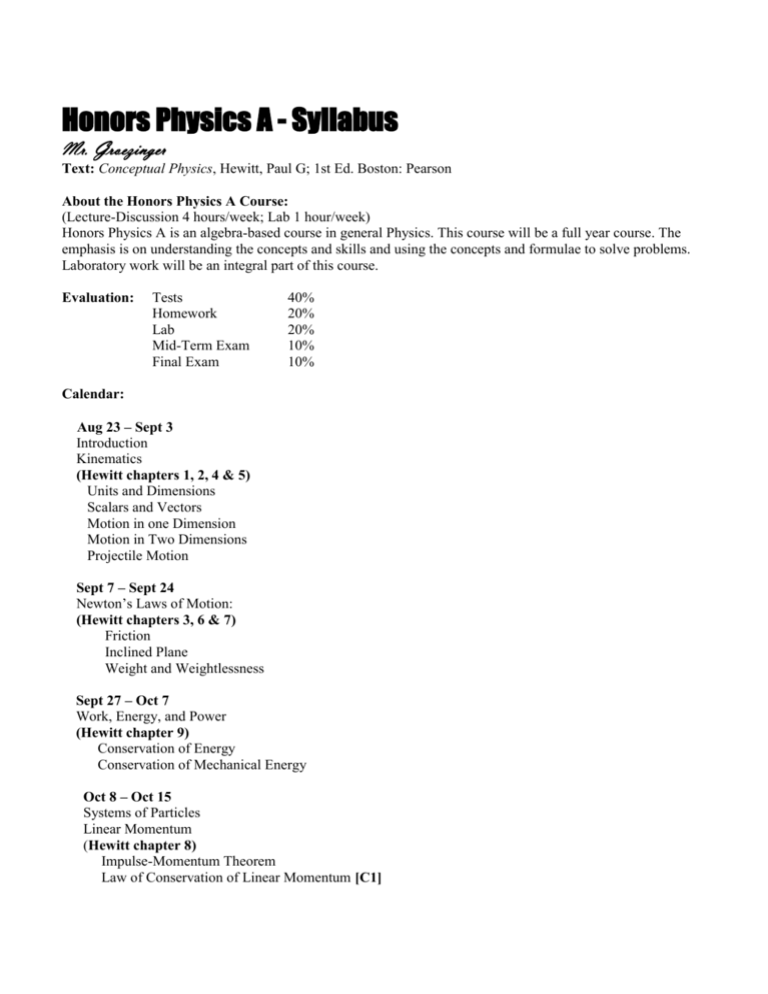
Honors Physics A - Syllabus Mr. Groezinger Text: Conceptual Physics, Hewitt, Paul G; 1st Ed. Boston: Pearson About the Honors Physics A Course: (Lecture-Discussion 4 hours/week; Lab 1 hour/week) Honors Physics A is an algebra-based course in general Physics. This course will be a full year course. The emphasis is on understanding the concepts and skills and using the concepts and formulae to solve problems. Laboratory work will be an integral part of this course. Evaluation: Tests Homework Lab Mid-Term Exam Final Exam 40% 20% 20% 10% 10% Calendar: Aug 23 – Sept 3 Introduction Kinematics (Hewitt chapters 1, 2, 4 & 5) Units and Dimensions Scalars and Vectors Motion in one Dimension Motion in Two Dimensions Projectile Motion Sept 7 – Sept 24 Newton’s Laws of Motion: (Hewitt chapters 3, 6 & 7) Friction Inclined Plane Weight and Weightlessness Sept 27 – Oct 7 Work, Energy, and Power (Hewitt chapter 9) Conservation of Energy Conservation of Mechanical Energy Oct 8 – Oct 15 Systems of Particles Linear Momentum (Hewitt chapter 8) Impulse-Momentum Theorem Law of Conservation of Linear Momentum [C1] Oct 18 – 26 Circular Motion and Rotation (Hewitt 10-11) Uniform Circular Motion Torque and Rotational statics Rotational Kinematics and Dynamics Angular Momentum and its Conservation Oct 27 – Nov 24 Oscillations and Gravitation (Hewitt chapters 12 – 14) Simple Harmonic Motion Mass on a Spring Pendulum and Other Oscillations Newton’s Law of Gravitation Circular Orbits Nov 29- Dec 1 Temperature and Heat (Hewitt chapters 21-22) Heat Temperature Thermal Expansion Heat Transfer Dec 2 - 17 Kinetic Theory and Thermodynamics (Hewitt chapters 23-24) Ideal Gas Laws and PV diagrams Kinetic Theory and rms speed of gas molecules Reversible Thermodynamic Processes Heat Engines and the Carnot Cycle First law of Thermodynamics Second Law of Thermodynamics Entropy Jan 3 – 11 Electrostatics (Hewitt chapters 32-33) Coulomb’s Law Electric Field Motion of Charged Particle in Electric Field Electric Potential Energy and Electric Potential Jan 12 – 19 Conductors, Capacitors, Dielectrics (Hewitt) Electrostatics with Conductors Capacitors Dielectrics Jan 20 - Feb 3 Electric Circuits (Hewitt chapters 34-35) Current, Resistance, Power Steady State DC Circuits Capacitors in Circuits Feb 4 - 11 Magnetic Fields (Hewitt chapter 36) Forces on Moving Charges in Magnetic Fields Forces on Current Carrying Wire Fields of Current Carrying Wires in Magnetic Fields Ampere’s Law Feb 14 – 23 Electromagnetism (Hewitt chapter 37) Electromagnetic Induction Inductance Feb 24 – Mar 4 Wave Motion (Hewitt chapter 25-26) Traveling Waves Properties of Sound Standing Wave and Beats Doppler Effect Maxwell’s Equations Mar 7 - 23 Geometric Optics (Hewitt chapters 27 - 29) Reflection and Refraction Mirrors Lenses Mar 24 – Apr 1 Physical Optics (Hewitt chapters 30 - 31) Electromagnetic Spectrum Snell’s Law Total Internal Reflection Image Formation by Plane and Spherical Mirrors Image Formation by Lenses Image Formation by a Two-Lens System Interference and Diffraction Apr 5 - 15 Atomic Physics and Quantum Effects (Hewitt chapters 38 - 39) Photoelectric Effect Energy and Linear Momentum of Photon Energy Levels in an Atom DeBroglie Hypothesis Compton Effect Apr 18 - 21 Nuclear Physics (Hewitt chapter 40) Nuclear Reactions Mass-Energy Equivalence Apr 25 – May 6 Special Relativity (Hewitt chapter 15) Frames of Reference Space-Time Travel May 9 – 20 General Relativity (Hewitt chapter 16) Mass, Energy, and Gravity May 23 – June 2 Review for Final Exams Fall Laboratory Inquiries: 1. Rebound height 2. Indirect measurement of inaccessible heights and distances 3. Areas, Volumes, and densities of given solids and liquids 4. Prediction and reproduction of kinematics graphs with motion detector 5. Determination of acceleration due to gravity 6. Projectile Motion – Relationship between θ and Range 7. Elastic Force in Rubber Bands – Nonlinear spring 8. Inclined Plane – Coefficient of friction 9. Uniform Circular Motion – Relationships between F and r c 10. Conservation of Mechanical Energy Spring-mass system – Air Track 11. Conservation of Linear Momentum – Air Track 12. Spring-Mass System – Force sensor 13. Simple Pendulum - Photogate 14. Density Using Archimedes Principle 15. Dependence of Cooling Rate on Surface/Volume Ratio Spring Laboratory Inquiries: 1. Electrostatics – Ordering the given materials in the order of their electronegativity 2. Mapping Electric Fields I: Plotting equipotential and field lines 3. Mapping Electric Field II: 3-D Landscape 4. Ohm’s Law and Internal Resistance 5. Resistors in Series and Parallel 6. Standing Waves on a String 7. Standing Waves for sound in a pipe 8. Verification of the Laws of Reflection and Refraction 9. Image formation by Spherical Mirrors and Lenses 10. Young’s Double-Slit Experiment 11. Single Slit Diffraction and Diameter of Hair 12. Photoelectric Effect Laboratory Notebook Format Problem/Question Hypothesis Experimental Procedure Data/Observations (in the form of a data table, graph and/or equation) Calculations Conclusion and error analysis HONORS PHYSICS Mater Lakes Academy 2011-2012 Mr. Groezinger Materials Needed (bring to class each day): - A TI-84 Plus Graphing Calculator (regular or silver edition). This will cost you a few dollars, but it is a very worthwhile investment in your education. - A class notebook dedicated to Physics. - At least 100 sheets of loose leaf graph paper for notes and homework assignments. - A quad-ruled notebook (graph paper notebook) to be used as a dedicated laboratory notebook. - A ruler calibrated in both inches and centimeters. - A protractor. - Writing and graphing materials (pencils and colored pencils). Class Expectations: - Homework will be assigned almost daily and will be collected the following class period. It will often be graded. DO NOT COPY A CLASSMATE’S HOMEWORK and turn in as your own work. If you choose not to do an assignment you must give me a piece of paper which states, “I did not do my homework because…” - If you are absent from class it is your responsibility to make up the work you missed. You have 48 hours to make up missing assignments once you return to school from your absence. This applies only to excused absences. You will not be given an opportunity to make up homework, quizzes, labs, or tests from unexcused absences. - Quizzes will be given periodically. Some will be announced beforehand, some may not be. - Tests will always be announced beforehand. If you have an excused absence the day of a test or quiz you have 48 hours upon your return to school to make up the test or quiz. - You will be issued a textbook for this class. Return the textbook at the end of the school year in good condition or you will be charged for it. - Come to class in an approved school uniform. - Do not bring food or drink into the classroom. If I see food or drink I take it. - Do not let me see you cell phones, I-Pods, MP3 players, or cameras. If I see them I take them and your parents may come pick them up.
